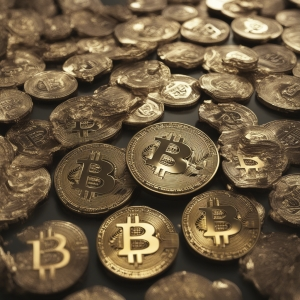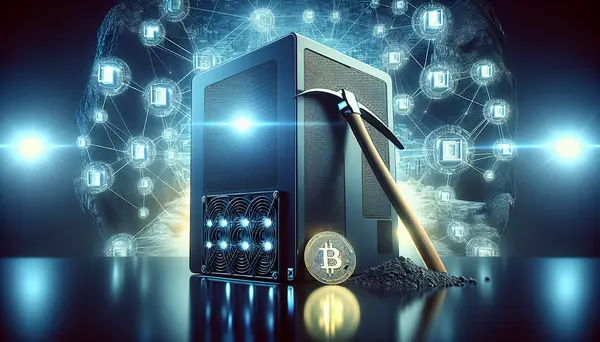Table of Contents:
Introduction: A Deep Dive into the Science of Bitcoin Mining
Understanding the science of Bitcoin mining can be a challenge, especially for beginners. Yet, it is a critical component of the cryptocurrency world. Mining is not just about computers solving complex mathematical problems. There is a whole scientific process behind it, a process that ensures the safety, accessibility, and durability of Bitcoin as a currency. In this introductory section, we'll take a profound dive into this fascinating journey, making it easy and relatable for beginners and enthusiasts alike.
By comprehending the science behind Bitcoin mining, you will gain an improved view of what makes Bitcoin and other cryptocurrencies an integral part of our financial sectors today. This detailed guide will demystify what takes place beneath the surface in the Bitcoin mining world, from understanding the blockchain technology to the role of miners in creating new bitcoins and maintaining the network's security.
Get $500 free Bitcoin mining for a free testing phase:
- Real daily rewards
- 1 full month of testing
- No strings attached
If you choose to buy after testing, you can keep your mining rewards and receive up to 20% bonus on top.
Understanding Bitcoin: The First Cryptocurrency
Before diving into the science of Bitcoin mining, it is essential to grasp the concept of Bitcoin itself. As the pioneer of cryptocurrencies, Bitcoin, birthed by an individual or group named Satoshi Nakamoto, made its debut in 2009. Bitcoin came as a digital currency with no physical form and no central authority, such as a bank or government, to control it.
Unlike traditional money, Bitcoin solely operates on an online network known as the blockchain. This network makes all transactions transparent and prevents double-spending or counterfeiting, problems often encountered in the world of traditional finance. Bitcoins are stored in a 'Digital Wallet,' from where they can be sent or received like any digital data.
Now we have a basic understanding of Bitcoin, let's take a more in-depth look into the fascinating science behind its creation and transaction verification - Bitcoin mining.
Pros and Cons of Bitcoin Mining
| Pros | Cons |
|---|---|
| Decentralization: No central authority can control Bitcoin. | Environmental Impact: Bitcoin mining uses significant amounts of energy. |
| Transparency: All transactions are publicly recorded on the blockchain. | Volatility: The value of Bitcoin can fluctuate rapidly. |
| Security: Mining contributes to the security of the Bitcoin network. | Regulatory Risk: The legal status of Bitcoin mining varies by country. |
| Profitability: Miners can earn rewards in the form of new Bitcoins. | Difficulty: The complexity of mining increases over time. |
The Science Behind Bitcoin Mining

The science of Bitcoin mining revolves around a decentralized network of miners. But what are these miners, and what do they do? Essentially, Bitcoin miners are powerful computer systems that verify transactions on the Bitcoin network. They collect recent Bitcoin transactions into 'blocks' and attempt to solve a computationally difficult puzzle.
The miner who solves the puzzle first gets to place the next block on the blockchain and claim the rewards. The rewards include transactions fees from the compiled transactions and newly created bitcoins. The process of solving these puzzles and adding transactions to the blockchain is what constitues the term 'Bitcoin mining'.
It's important to understand that this process isn't as easy as it sounds. Finding a solution to the puzzle involves guessing sequences of numbers called 'hash.' It is a trial and error process as there are almost near-infinite possible hashes. However, the more powerful your mining hardware, the more hashes you can guess per second, and the higher your chances of solving the puzzle!
As you've probably figured out by now, the science of Bitcoin mining is an combination of computer science and mathematical principles brought together to secure the Bitcoin network.
Bitcoin Mining: The Resource-intensive Process
Another crucial aspect of the science of Bitcoin mining is the resource-intensive nature of the process. Remember when we mentioned the powerful computer systems miners use? Well, these systems are designed with specialized hardware that uses significant energy to make the high-speed and intense mining computations possible.
Notably, the Bitcoin mining process is designed to be difficult to ensure that the number of blocks found each day by miners remains steady. This means as more miners join the network, the difficulty of the mining puzzle increases. With increased difficulty, more computational power and energy are needed, making Bitcoin mining an increasingly resource-intensive process.
The high energy demands of Bitcoin mining have brought with it concerns about environmental impacts. However, the Bitcoin network is constantly evolving, with efforts made towards more energy-efficient mining processes and the use of renewable energy sources.
Therefore, understanding and embracing the science of Bitcoin mining is not only about appreciating the technology that underpins Bitcoin but also recognizing its impact on resources and actively working towards making it better.
Understanding Blockchains: The Backbone of Bitcoin Mining

In the science of Bitcoin mining, the blockchain takes center stage. Simply put, a blockchain is an unceasingly growing list of records maintained across numerous computers, so no single entity has control. These records, or blocks, are linked using advanced cryptography, increasing security and reliability.
Every block contains a hash (a unique mathematical code) of the previous block, a timestamp, and the transaction data itself. This design means that manipulations are almost impossible since a hacker would have to alter all subsequent blocks following the altered block and the chances for this happening are close to zero.
Miners play a crucial role in this blockchain process. When a Bitcoin transaction is made, miners take this data, hash it into a short string of numbers and letters using a complicated mathematical equation, and add this hash to the end of the blockchain. This ensures that the transaction is validated and permanently recorded in the blockchain.
The existence of blockchain is fundamental in the science of Bitcoin mining. Besides offering secure and transparent transactions, this technology also ensures that only mined bitcoins are used in transactions, preventing fraudulent activities that could crash the entire Bitcoin network.
In sum, blockchains are the backbone of Bitcoin mining, offering the transparency, security, and innovation that give Bitcoin and other cryptocurrencies their unique appeal.
The Role of Mining in Maintaining Bitcoin's Decentralization
The concept of decentralization stands strong in the science of Bitcoin mining. This underlying principle ensures that no single institution or governmental body can control or manipulate its value. Here's where mining comes in. In a nutshell, miners keep the Bitcoin network decentralized by making it challenging for any individual or group to take control over the network.
Miners from all around the world contribute their computing power to confirm and secure transactions. In doing so, they prevent any potential attacks that would attempt to double-spend or alter past transactions. Should any rogue miner attempt to introduce a fraudulent transaction into the network, their version of the Bitcoin ledger would be rejected by other miners.
Furthermore, manipulating the Bitcoin network would require an enormous amount of computational power, an investment that would not make economic sense considering the system's inbuilt reward mechanisms. For miners to continue functioning, they need the rewards earned through mining, which would cease to hold value if the network's security is compromised.
The key takeaway is that miners not only play an integral role in executing transactions and generating new Bitcoins but are also guardians of the decentralized nature of Bitcoin. This double-check mechanism makes Bitcoin an extraordinarily secure digital currency, maintaining trust in the network, and underlining the importance of understanding the science of Bitcoin mining.
Perks and Pitfalls of Bitcoin Mining Science

Recognizing the benefits and challenges of the science of Bitcoin mining is essential for anyone venturing into the realm of cryptocurrencies. The primary draw of Bitcoin mining is the potential rewards. Successful miners earn bitcoin as a reward for their hard work. This cryptocurrency can then be held as an investment or exchanged for fiat currency or other digital currencies.
As mentioned earlier, the process of mining involves solving complex mathematical puzzles and is highly competitive due to the potential rewards at stake. This competition contributes to the network's security by making it incredibly difficult, if not impossible, for any single party to control or manipulate the blockchain.
However, the science of Bitcoin mining is not without its challenges. The high-energy consumption of mining processes is not only a significant cost concern but also presents environmental issues. Additionally, as the complexity of mining increases, individual miners may find it difficult to compete against large mining pools with considerable computational power.
Furthermore, the volatility of Bitcoin's value means that despite these obstacles and the time and resources invested, the rewards may not always be profitable. Future regulatory measures also introduce an element of risk and uncertainty.
Understanding the science of Bitcoin mining, as well as its pros and cons, can help potential miners make informed decisions and contribute positively to this dynamic field.
The Environmental Impact of Bitcoin Mining
The science of Bitcoin mining is not without its controversies, the most notable of which is its environmental impact. With Bitcoin mining requiring high levels of computational power, there are concerns surrounding the amount of electricity it consumes. Some estimates even suggest that Bitcoin mining consumes as much power as some small countries.
Consequently, a significant proportion of Bitcoin mining activities are reported to occur in regions where the cost of electricity is low, or the climate is cooler. These areas may be more reliant on non-renewable energy sources, which raises concerns about the carbon footprint of Bitcoin mining.
Going forward, the Bitcoin mining industry is exploring options to reduce its environmental impact. Some potential solutions being considered include transitioning to renewable energy sources, using more energy-efficient mining machines, and mining only during periods of low electricity demand. This heightened consciousness towards sustainable mining practices demonstrates the industry's willingness to adapt and evolve in response to environmental concerns.
As someone interested in the science of Bitcoin mining, part of your journey includes staying updated not just on the technical developments, but also on these relevant socioeconomic and ecological aspects of the industry. Understanding these issues helps make clearer, more well-informed decisions about the future of Bitcoin and other cryptocurrencies.
Conclusion: The Complex Simplicity of Bitcoin Mining Science
With a journey that starts from understanding Bitcoin, through comprehending the demanding process of Bitcoin mining to appreciating the robust technology of blockchain, the science of Bitcoin mining is indeed an intricate but revealing expedition.
This expedition, while complex in its technicality, outlines straightforward principles. The decentralization, transparency, and stringent security measures embodied in the Bitcoin mining process echo the core features of digital currencies that gear towards financial autonomy, accuracy, and privacy.
Understanding the science of Bitcoin mining is a fundamental step towards bigger conversations about digital currencies, their benefits, challenges, and standpoints in the financial sector. We are witnessing an era where digital currencies like Bitcoin are not just mediums of exchange but an entire revolution of how we perceive and handle value.
As we plunge further into the cryptocurrency world, it is crucial to keep learning, evolving, and, when possible, contributing to the technology powering this progression. In the grand scheme of things, every enthusiast or beginner clutching the knowledge of Bitcoin mining science is in their unique way, a miner - digging to unearth the broader horizons of digital finance.
Understanding the Fundamentals of Bitcoin Mining
What is the science behind Bitcoin mining?
Bitcoin mining involves solving complex mathematical problems using high power computing. This process enables transaction verifications, thus maintaining the network's security and issuing new bitcoins into circulation.
How does Bitcoin Mining secure the network?
Bitcoin mining secures the network by verifying transactions and recording them onto the immutable blockchain, making it significantly difficult for any malicious alterations.
What role does hash function play in Bitcoin Mining?
In Bitcoin mining, hash functions are part of the mining algorithm used to confirm transaction data or other details in a blockchain block. It helps ensure the data's integrity.
Why does Bitcoin Mining consume so much energy?
The process of Bitcoin mining requires a significant amount of computational power to solve the algorithms and secure the network, leading to high energy consumption.
What is the significance of Bitcoin Mining rewards?
Bitcoin Mining rewards are one of the main incentives that attract miners to maintain the Bitcoin network's transactions. Rewards are essentially newly created bitcoins and transaction fees.






